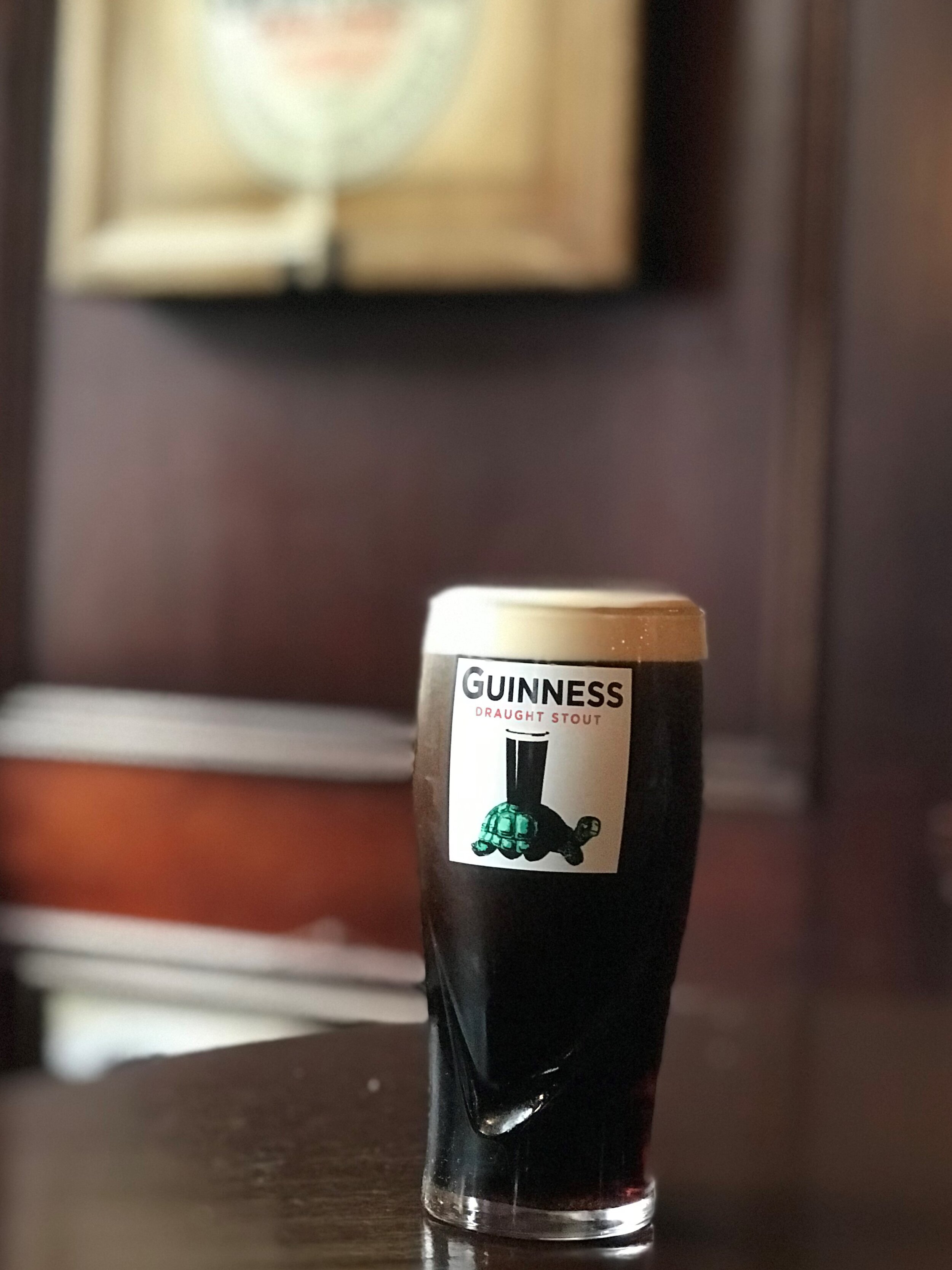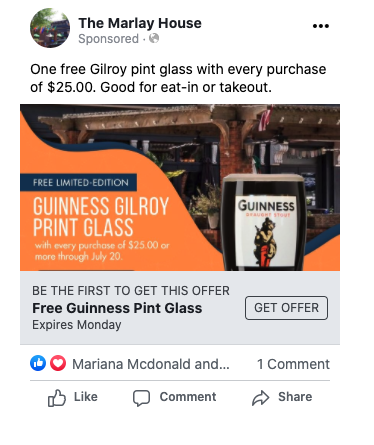What online advertising platform works best?
In July, the PosterMyWall team decided to get an answer to that so-very-important question: What online advertising platform delivers the best ROI?
The results to our experiment didn’t deliver a clear answer, but we did learn a few things that we think can help you get a jump start if you decide to try online advertising for yourself.
The mission
PosterMyWall set up its experiment in partnership with The Marlay House, a neighborhood Irish pub in Decatur, Georgia. Like other restaurants that have reopened since the original COVID-19 shut down, The Marlay House is exploring new ways to promote itself to new customers and to keep its existing customers coming back.
The Marlay House’s strategies have included expanding its outdoor seating area by adding tables on its lawn and to parts of its parking lot. (The Marlay House was fortunate to already have a large outdoor patio.) The restaurant has also added family dinners to its menu—items like a full meal of brisket, mashed potatoes, and a vegetable portioned for four people. There are also new menus and and special holiday offerings—such as Mother’s Day Brunch and Father’s Day Grill Kits—all packaged to take home. The Marlay House also added curbside pickup and delivery to customers within a three-mile radius. And on sunny days, they roll the piano (and piano player) out onto the patio.
In addition, The Marlay House has become more active with its online marketing and social media by regularly updating its specials menu on its website and by posting to Facebook nearly daily. Before COVID, The Marlay House only posted to Facebook when there was a special event. (The Marlay House posted minimally on Instagram both pre-COVID and since.)
These tactics got The Marlay House back to about 75% of its normal revenue.
Our goal was to see if, with a very modest advertising budget (no more than $100 per platform), we could drive measurable traffic.
The offer
PosterMyWall worked with Colin Comer, The Marlay House’s proprietor, to create an offer that would appeal to his customers—which consist largely of neighborhood residents, including families who come in to dine with their children. Most are repeat customers, and many are regulars who come by to hang out with friends, watch Major League Soccer games, or listen to live music.
Colin just happened to have a stock of Guinness Gilroy pint glasses that had been provided by Guinness as a promotional item. Gilroy pint glasses, which feature illustrations such as the famous Guinness toucan, are considered collectors’ items. The glasses seemed like the perfect incentive.
Colin decided that he could give away one free pint glass with every purchase of $25.00—eat on-site or take-out. We used PosterMyWall’s free graphic design tool to make a graphic ad that featured a photo of The Marlay House and a photo of a Gilroy glass. We assigned a different, easy-to-remember redemption code to each platform (i.e. JulyBook for Facebook and JulyGram for Instagram). Then we set up campaigns in Facebook, Google Ads, Google My Business, Instagram, Nextdoor, and Untappd—limiting ourselves to a spend of no more than $100.00 on each platform over a ten-day period.
What happened?
We have to admit we were a little disappointed with our results. In the end, one of The Marlay House employees tested positive for COVID during our promotion, so the restaurant closed for three days for cleaning—right in the middle of our promotion! And unfortunately, we have no idea how that impacted our results.
What we do know is that in the end, only five customers asked for glasses—all of which referenced the Facebook code. So the good news is that Facebook was approximately a break even in terms of revenue ($99.00 ad cost to drive $125.00 in revenue) If you factor in the 7,592 people reached and 91 clicks, we consider Facebook a win.
Google My Business delivered only 4 clicks. But it was free—so definitely worth the effort.
Google Ads delivered 161 clicks (a cost of about $ .76 per click) so that was a win too—sort of.
See a comparison of the results and the full details on Google Ads and the other platforms below—
Facebook was the obvious choice of where to place and ad because that’s where The Marlay House has its primary social media presence. We allocated an ad spend of $10.00 per day over a ten-day period starting July 5. Our total, as we said above, was 7,592 reaches and 91 clicks for an average cost of $1.03 per click.
It should be noted that we used a newer Facebook product—the offer ad—which is meant to drive traffic and shows up as a coupon people can click to save. When they are near the advertiser’s place of business, a reminder is activated to remind the customer that they are in the vicinity of an establishment where they have an active coupon.
Diving into the number of clicks per day, we found that, after a good response on the initial Sunday we started running the ad, the number of clicks per day dropped by about 50% on Tuesday, Wednesday, and Thursday—before increasing again. That pattern was not repeated the following week. We’d need to experiment more to know for sure, but this leads us to believe that the week following a holiday weekend (remember we started on July 5) isn’t the ideal time to run ads.
In terms of how we targeted our audience, we used Facebook’s demographic options to target people 18 and over who were interested in family, food, and beer. There are many, many options for narrowing down who sees your Facebook Ads by interest, job title, and more, so we recommend you go into the ad set-up to explore and plan in advance of when you want to run your ad. That way you select the options you want to use without the pressure of a deadline.
Facebook Ads have an option to target people within a specific radius of your location, but the smallest radius you can set is 10 miles—which is too large for a neighborhood hangout like The Marlay House. Instead, we selected about ten zip codes adjacent to The Marlay House’s location and targeted people who live in those.
Facebook’s reporting also included a breakdown by the ages and genders of the people who the ad was shown to. Although the ad wasn’t shown to many people in the 18-25 demographic, it was a greater percentage than the percentage in that age group who are actual customers. Therefore, if we were to run the promotion again, we would change our target age to 26 and over.
Google Ads
We invested $122.50 in Google Ads, formerly Google Adwords. This net 1,073 impressions and 161 clicks—which equals a cost of $ .76 per click. Although this was the lowest cost-per-click of any of the platforms we experimented with, a scan of the search terms revealed that some of the people the ad reached were likely already looking for The Marlay House.
In other words, in many cases, we were preaching to the choir.
However, you also have to take into account the value of Google Ads is that they reach people when they are actually in the act of doing research and are likely to pay attention to what they see. This contrasts with Instagram advertising which appears randomly and not at a time when the customer is actually looking for your restaurant.
No one used the Google Ads redemption code, so we can’t tell if the Google Ad actually drove any purchases.
It’s also important to note that Google Ads is a text-only listing—so it was not a good platform for a promotion like ours where the image of the giveaway was key to communicating the value of the offer.
Google My Business
Google My Business is Google’s FREE business directory. This listing comes up on both Google Maps and shows links to your business’ website, phone number, and a map to its location. We were able to include the display ad featuring the image of the free Gilroy pint glass—also free.
We received 299 views and 4 clicks. No one used the Google My Business redemption code.
We posted the promotion as an offer on Nextdoor, the online neighborhood hub platform. This resulted in a version of the display ad that resembled a coupon. For our $100.00 investment, Nextdoor told us we received 63,258 views—but we have virtually no insight into who those views were or if they fit our target audience. Nineteen people clicked on the ad and two clicked that they wanted the coupon for the free Gilroy pint glass—but not a single customer mentioned Nextdoor in conjunction with the free Gilroy pint glass offer.
On Instagram, where The Marlay House doesn’t post regularly, we allocated an ad spend of $10.00 per day over a ten-day period starting July 5. Instagram reached 26,352 people and drove 11 clicks—coming out to $3.79 per click. The low click rate might be partially our fault, as we selected “reach” for our intended outcome as opposed to another option such as “conversions” or “store traffic.” Plus, we ran a static ad in the Instagram feed section. A carousel or video might have done better—or possibly we should have run our ad in the Instagram Stories section. It would take multiple additional trials to know for sure.
In terms of how we targeted our audience, we used the same demographic options as we did on Facebook: people 18 and up who were interested in family, food, and beer.
Untappd
Untappd is a directory specifically designed to help beer lovers find new bars and beers. Although we were able to promote the free Gilroy pint glass as an event, we weren’t able to post the display art—so our ad was underwhelming at best. It was free—and Untappd does target the right audience. So we’ll watch and see if, over time, Untappd improves its display advertising options.
Here’s what we learned:
You have to be patient. There is a lot of trial and error involved in online advertising. It will likely take several experiments to figure out what the right platform and offer is for your business—and to determine which options within each platform are going to work best for you.
Set your goal. Reach, clicks, or purchases? And how narrow is your demographic? Choosing the right platform means knowing whether you want to cast a wide net for exposure, or connect with a narrower audience who is more likely to click or buy.
Plan for the click. While our ads communicated our offer, if anyone clicked on the ad, it took them to The Marlay House’s landing page—a page that didn’t mention the offer. It would be worth experimenting to see if adding the promotion to the website would impact the final results.
You don’t always have to pay to play. The best value is Google My Business—because it’s FREE. At least for now.
Understand what it takes to drive your audience. Our low redemption may have been linked to our offer. Perhaps the audience would have preferred a buy-one/get-one-free deal to the free glass. Perhaps not. It takes lots of talking to your customers and experimenting with promotions to determine the right offer to motivate people to action.
Know which platform your audience is on. Facebook out-performed Instagram—but perhaps that was because that is where The Marlay House has cultivated a following. Without experimenting, we don’t know whether a restaurant with an Instagram presence but little Facebook following would get the same result—or the opposite.













